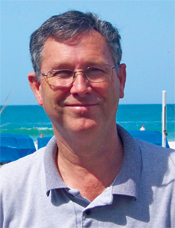Five Minutes With Audio & Video Home
fiveminuteswith
Plumbing and Water Conservation with Bob McManaway
Bob McManaway, Director of Plant Operations and Support Services with TradeWinds Island Resorts & Conference Centers in St. Pete Beach, Fla., discusses strategies for implementing water-saving initiatives.

Robert (Bob) McManaway
Director of Plant Operations & Support Services
TradeWinds Island Resorts & Conference Centers
St. Pete Beach, Fla.
Your facility began implementing water-saving measures in 2002. How did your department monitor water use in restrooms to better determine the types of products to specify for your facility?
All decisions for the change-out of water fixtures have to compare the value of the actual savings to the cost of implementing the project. Some of these changes may be required in an effort to be green. Many of those types of recommendations, including aerators, low-flow faucets, and automatic shut-off fixtures, have a proven track record and may be a mandatory part of any green effort. TradeWinds has implemented all of these types of basic changes.
The challenge is to avoid the unintended consequences that occur in the environment in which you use the fixtures. Water faucets with motion sensors or electric eyes may have adjustable timing that regulates the length of time a fixture operates. But a well-placed piece of toilet paper across the lens may cause the unit to continue to operate when the restroom is unoccupied, defeating the original intent.
TradeWinds recently completed a renovation project that required the removal of the urinals in our main conference’s classroom area. This project also required a subsequent storage of the flush valves while workers completed the tile work. The cost of replacing these still serviceable valves was not a component of the original capital-improvement plan.
When a suggestion was made that we should go ahead and install newer, low-flow valves, discussion about the potential need to have to rebuild the valves before reinstalling came to light. Would there really be a return on investment if newer, more efficient, low-flow valves were installed, rather than rebuilding the older valves?
To figure out how much savings would be involved was fairly simple. We took the known water savings per flush and then tracked the number of trips to the men’s room during a day of conference meetings. The rest was easy math and revealed an unexpected ROI in less than three months.
Your facility has reduced its water use by about 35 percent since establishing those water-conservation initiatives. What measures are generating most of those savings?
By far the greatest savings at a beachfront resort would occur through an effort to reduce the turns of room linen back to the laundry for rewashing. Going green and inviting guest participation in a mutual effort to reduce linen rewash accounted for almost a 30 percent reduction in potable water use, when compared to our baseline year.
Since then, we have achieved an additional 5 percent improvement directly attributed to the use of water-saving devices in guest rooms and service areas. We continue to tweak those processes on a regular basis to identify potential savings. Filtration systems, water softening, a regular titration of chemical mixes ensure we stay on track and are continually looking to improve.
What is your department's role in implementing these water-saving measures?
My specific role is to monitor the resort's compliance with the Florida Department of Environmental Protection's Green Lodge Program and to serve as an advisor when green issues arise. I play a more direct role in the operation of the resort laundry. A close relationship with our chemical vendors has helped us develop item-specific wash formulas that use only enough water necessary to clean the linen and to reduce chemical residuals so rinsing is done correctly the first time.
Even our choices of linen at the resort bundle the green concept. We recently put newer, heavier and more absorbent beach towels into service. We also encouraged our guests to keep the towel and to not return it for cleaning so often. I mentioned unintended consequences earlier. In this case, guests not only kept the towels out longer – sometimes for the entire duration of their stay – but also requested less of them. We’ve seen a drop of about 20 percent in total weight of towels washed each summer day as a result of this change.
Have you explored the possibility of implementing water-saving initiatives related to irrigation for landscaped areas?
TradeWinds already has implemented a program that uses reclaimed water for its irrigation. Many of our plants are native Florida tropicals that provide a xeriscaping-like benefit
What are the next steps your department will take to continue reducing the facility's water use?
Long-term plans might include retrofitting equipment to take advantage of new water-filtration systems. We are considering the retrofitting of our clipper-style washers that sump the final rinse water for reuse in the initial gross-debridement process in the dishwasher. This same methodology also is available for our laundry, as are some new techniques to filter the same water for direct reuse/mixing or to make it available for outdoor use as reclaimed water.
posted: 4/9/2009








